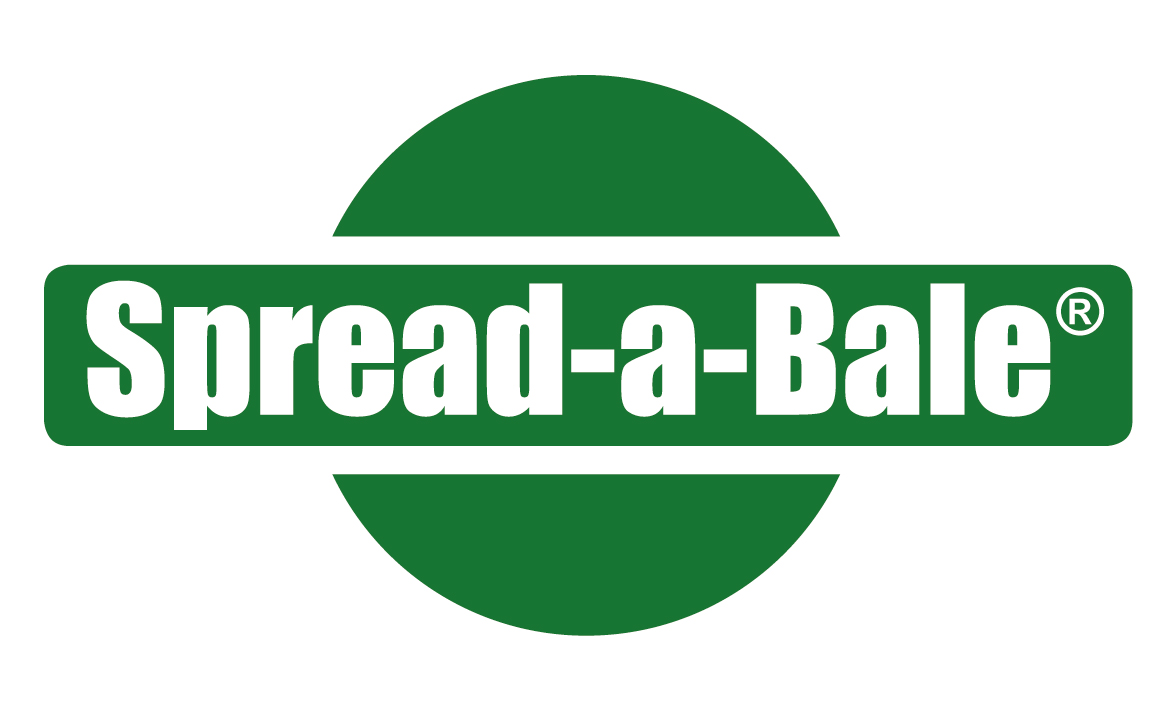Is the latest Side Throw variant from Spread-a-Bale a practical and functional option to operate in places the original variant may have struggled to cover?
The Spread-a-Bale is certainly no stranger to the agricultural market, with various iterations spanning more than 25 years of production. But what it does claim to be is a tried-and-tested product that holds favour with a long string of operators internationally, with one of the manufacturer’s largest footholds held in Germany.
Spread-a-Bale claims one of the biggest successes to the product is its simplicity and functionality, with models capable of fitting to most loader and handling equipment on the market. However, even with its market success, the original, forward-throwing Spread-a-Bale did not suit every building and farm.

Spread-a-Bale’s latest variant offers side throw capabilities both left and right, up to eight metres, offering greater operator visibility over forward discharge
Launched earlier this year, Spread-a-Bale’s latest variant looks to set the record straight by offering a side throw option for their Micro, Mini, Midi and Maxi ranges. Farmers Guardian took the Midi XL ST (Side Throw) on test to see how it performed.
Overview
Spread-a-Bale operates the same universal design throughout the range, with 21 different handler brackets available to suit the machine and manufacturer, and nine different loader options. With eight U-bolts holding headstock brackets in place, users can quickly and simply swap brackets to suit a machine, or a machine upgrade if needed.
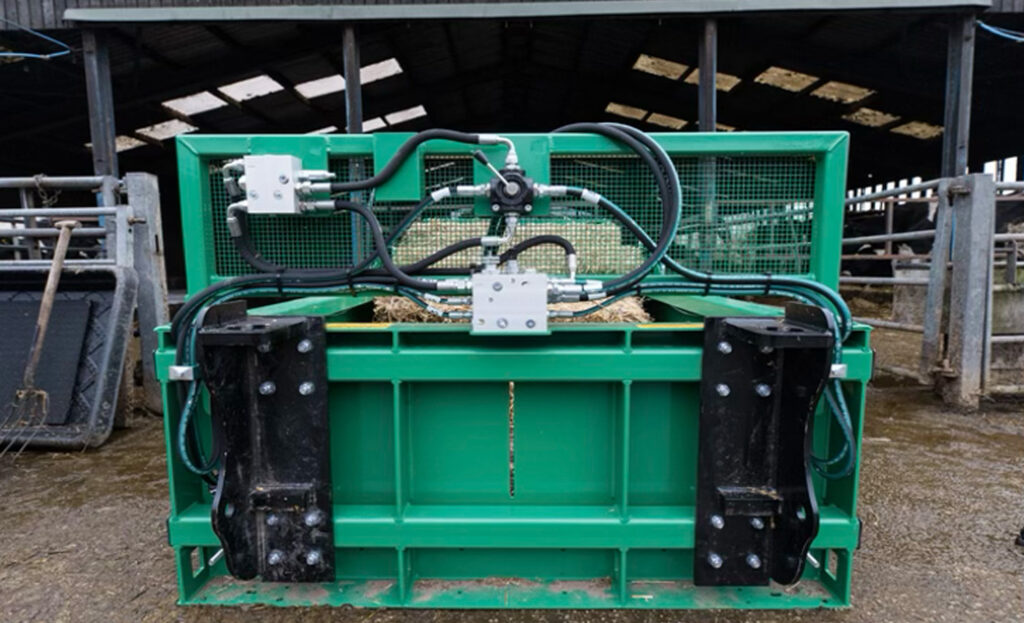
Mounted by eight U-bolts the headstock mounting plate can be easily changed to suit carriage.
For the purposes of the test, we operated with a cone and pin headstock. Two hydraulic pipes offer flow and return to the sequence valve, which controls the machine’s main functionality.
A diverter valve provides directional control of the working head – traditionally, Spread-a-Bale rotors would operate in a single direction. For the purposes of the side throw variant, the manufacturer has opted for multi-directional functionality. Allowing the side throw unit to discharge bedding both left and right, or forwards once selected.
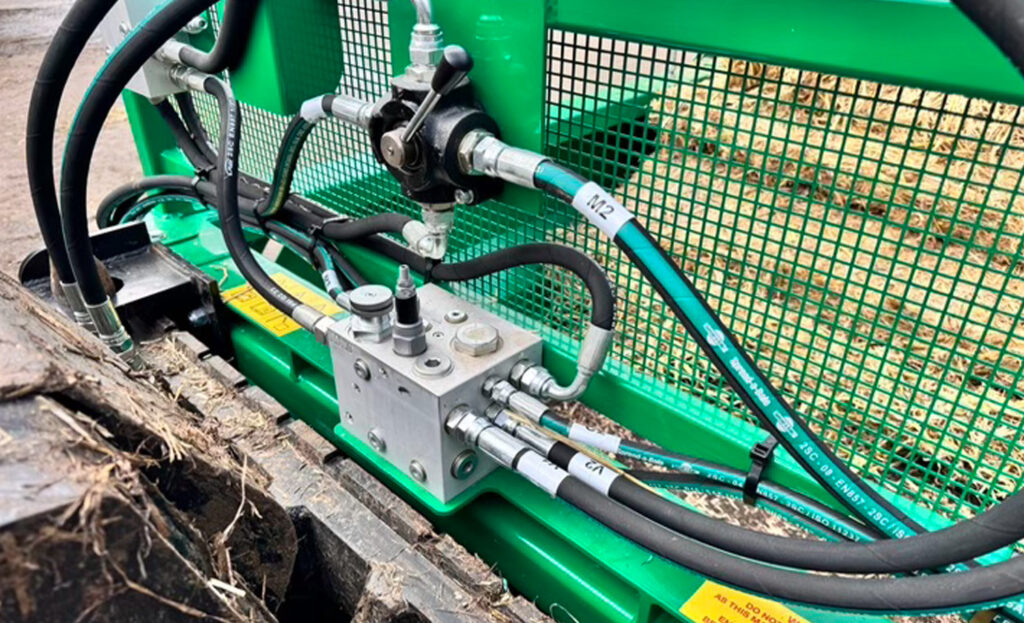
Drive comes from the operating machine’s double-acting spool, with the Spread-a-Bale’s sequence valve directing oil flow in operation
The XL in the test machine’s name indicates the machine’s length, with the larger XL capable of handling square bales up to 2.8 metres in length compared to 2.5m on the standard variant. Both machines will handle square bales from 1m in length and round bales up to 1.6m in diameter.
Operating and handling
Attachment of the machine is quick and simple. Once locked in place, it is only a matter of coupling the two hydraulic pipes to the machine. Bales are better positioned on clean, hard standing, with something to push against ready for loading. When loading, the unit operates the retracting sequence lifting the working head out of the way, and operating the feed belt to draw the bale into the machine.
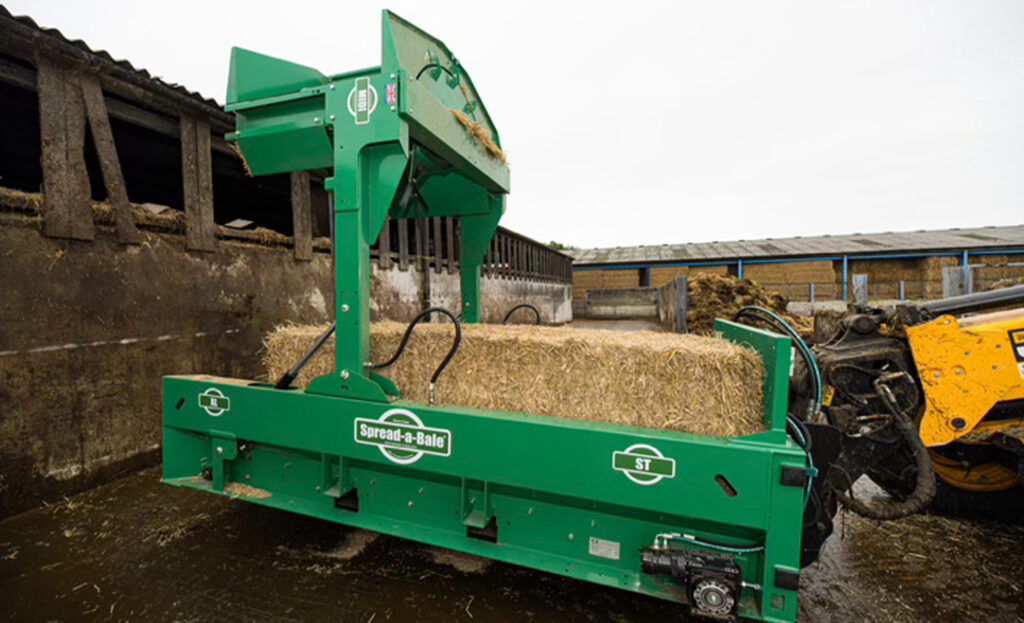
Preparation was required for loading bales, with a wall or stanchion to push up against so the feeder belt could draw the bale in
A blade-like edge aids getting under the bale, but without a wall to push against you can be left chasing the bale around the yard. The preferred choice is to have the knots at the top of the bale to make it easier to draw the string out of the bale. The main difference on the Side Throw variant is the directional guide on the front of the machine, with four spring-loaded locking pins used to lock and position the guide in both left and right positions.
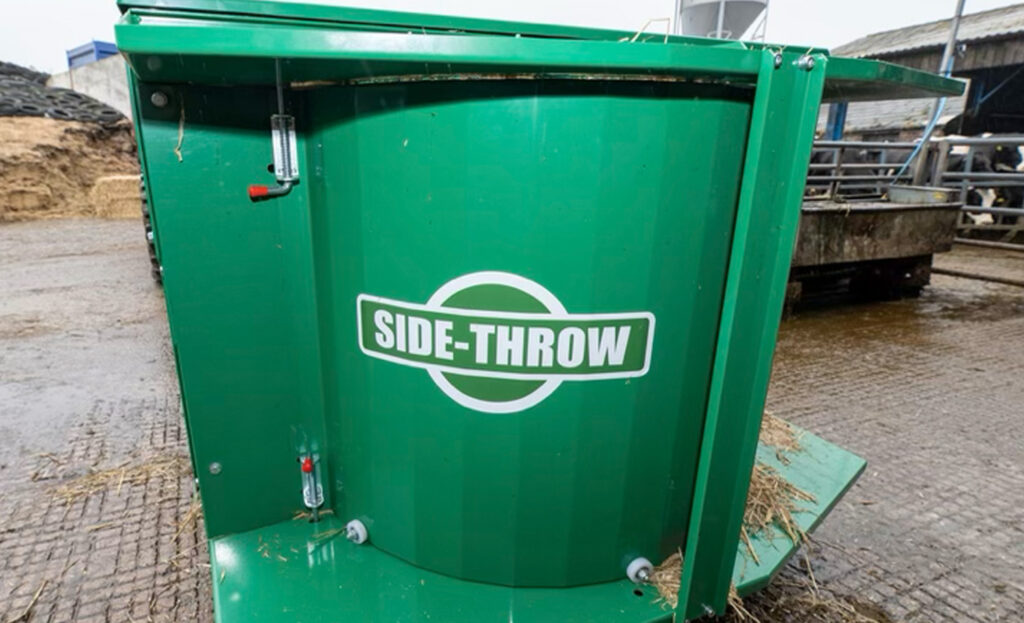
The Side Throw machine’s guide was easy to slide and lock into position with four spring-loaded pins
Once the guide is slid along its rail and locked into one of the two operational positions, the machine is set to work.
From an operational point of view, the Side Throw variant offered far greater operator visibility when bedding up to the side compared to the forward throwing functionality. The side shoot was found to create an obstruction for the machine’s forward throwing ability, limiting the spread pattern. If the plate could be removed quickly and easily this would benefit spread pattern, but the machine’s ability to throw forwards is only a small benefit to a machine designed to throw bedding sideways into pens.
FG Verdict
A business aspiring to gain the greatest operational efficiencies out of their equipment may favour the Spread-a-Bale system. Farm operations looking to run a lean business could find the system a sensible option making better use of handling equipment, and reducing the need for a second tractor on a straw chopper. The test machine had a 55-litre/min oil flow requirement making it suitable for most machines.
The Spread-a-Bale was simple and easy to use, and flow rate could be adjusted on the machine’s sequence valve to adjust the spread. The test team did think a hydrostatic handler with independent hand throttle control could offer the most customisable and precise operation of the Spread-a-Bale. Saying that, the test farm’s JCB TM320S handled the machine with ease.

The feed belt drive motor was felt to be exposed, protruding from the machine’s outer extremity
One of the main comments that came from operating such an implement, was the overall operational length. With the Midi XL ST standing at 4,101mm in length, plus operating vehicle, weighing in at 1150kg unladen, some questions were raised over the levering capability of the unit on the headstock if put beyond its parameters. That said, the TM handled the loaded machine well.
One of the main benefits of the side throw system is its ability to throw bedding to the left, right and forwards. This means you can work both sides of a feed passage without the need to turn and return in the opposite direction.

The test machine could also operate by throwing bedding forwards into pens, but the test team found the discharge guide compromised the spread pattern
With a 1,780mm working width, the machine could easily access most buildings with the operating vehicle size the only compromise to the machine’s access. Notably, having side-throw functionality meant the Spread-a-Bale could operate in tight corners and confined spaces, something machines only operating forward-throwing functionality may struggle with.
Varying consistency and type of bedding material will effect the machine’s throwing ability, with Spread-a-Bale claiming the machine will throw material between four to eight metres. The wheat straw used on the test farm consistently covered a distance of six metres (20ft), which was well suited to the pen size of the operation.
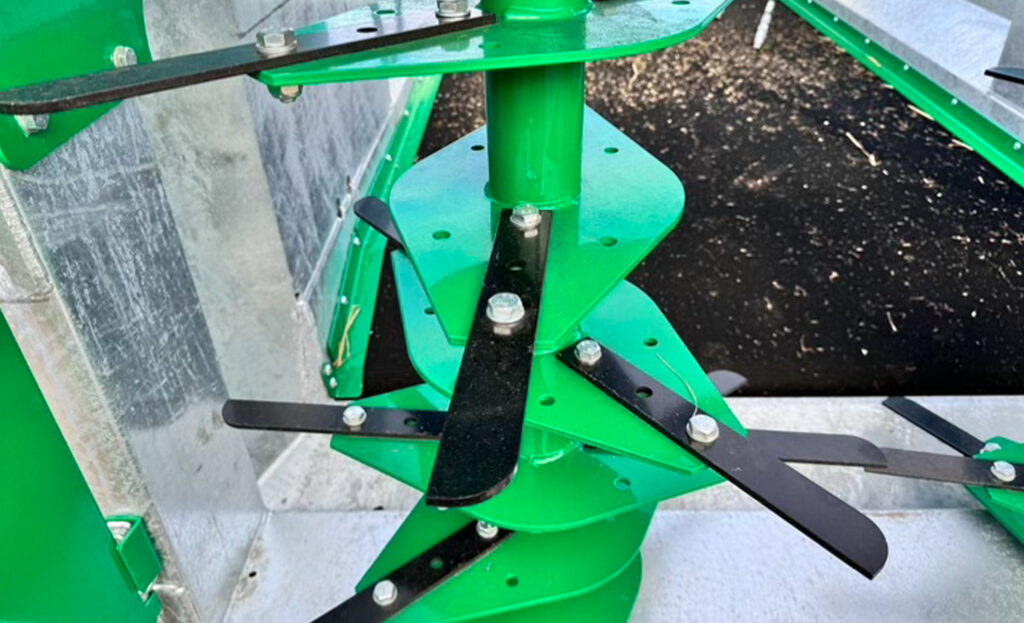
Anvil headed tines are supplied as standard on machines
A notable feature of the system is the way the machine teases bedding and throws it without chopping it. This both retained the straw length and had a noted difference in dust suppression compared to a straw chopper. It is also claimed the retention of straw length helps the bedding last longer, reducing bedding up cycles.
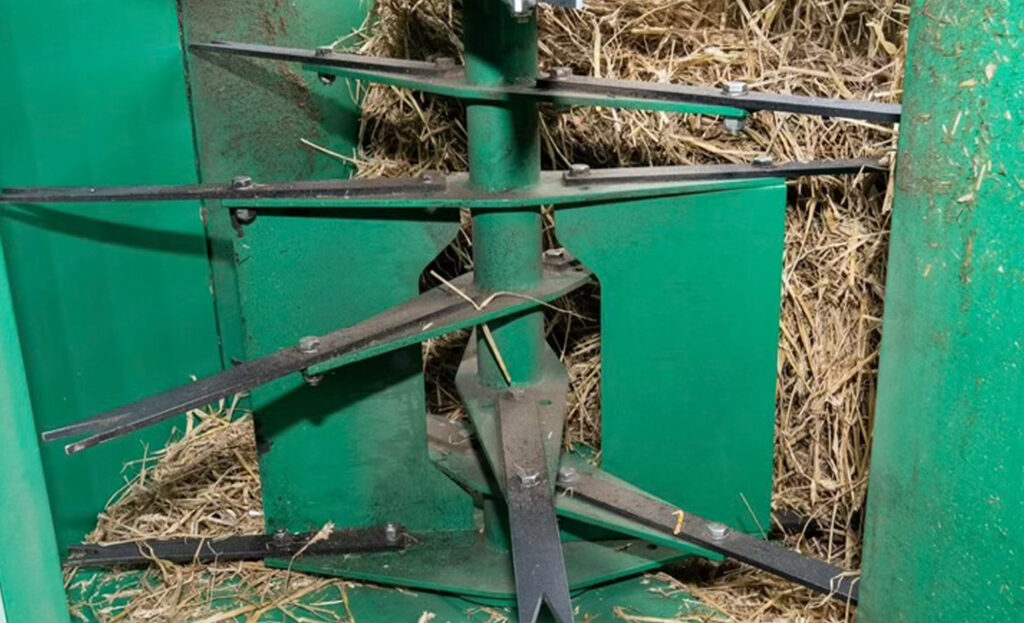
An optional reversible forked tine is offered to provide improved pulling and spreading of the material
The test machine did show an improvement in straw length compared to the test farm’s straw chopper. But only a long-term comparative study would indicate any reductions in straw usage.
Overall, the Spread-a-Bale Side Throw was functional and practical, providing everything that was required from it on test. Offered in a number of formats, the Side Throw could offer appeal in markets that may not have previously considered the machine due to lack of functionality in confined spaces.
